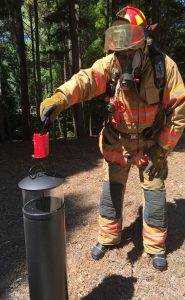GAHHHHHHHHH! My screams filled the office hallways on a Sunday afternoon. In agony, I hopped to the ice machine to find relief for my crushed toe. Moments before, while hanging my shiny new patent plaque on the wall, it dropped six feet and landed on my big toe joint. Since it was a hot summer day, I was wearing open-toed sandals, which did nothing to protect the vulnerable joint.
When Monday arrived and I could barely walk, I visited my employer’s on-site medical center to have my foot evaluated. The personnel insisted I file a safety incident report since the injury occurred in my office. I was embarrassed but did as I was told. The workman’s comp rep was baffled; she had never before seen “injury by patent plaque.”
Fortunately the toe was not broken, but the safety personnel entered the incident in their database nonetheless. They explained that the database helped highlight previously invisible hazards. For example, if multiple people reported trips in a certain location, perhaps the carpet needed to be adjusted. In my case, I had to call maintenance from that point forward to hang any patent plaques! Equipped with steel-toed boots and proper materials, they were better prepared to do the job.
At lunch the next week I quizzed my colleagues on some of their more embarrassing safety incidents. Kerri DeLair turned to check on her daughter while bike riding – and pedaled straight into a stop sign. Shelly Goodin tried to readjust a weight machine and crushed her finger. Philip Turner managed to drop an overhead grocery-store sign onto his head with – a quart of milk (guess you had to be there!).
Suffice it to say, weird safety incidents abound, and most industrial organizations have safety teams and programs devoted to predicting and preventing such incidents. Sadly, however, the data surrounding typical hazards tends to whisper, not scream. It is hard to pick out the tiny signals of impending problems amongst the noise of daily activities.
The results? Over engineering some safety programs and under-engineering others.

Perhaps, for example, full-blown fire protection gear might be overkill for lighting a candle, and bike helmets are unlikely to provide meaningful protection in a car crash. Yet safety programs in industrial environments are sometimes guilty of similar excesses.
Great attention might be paid to training initiatives when a look at the data might show that safety incidents are highly correlated to employees working excessive overtime. Perhaps a more effective program would be to ensure adequate rest breaks. Or, given that humans are only capable of seeing a certain amount of information at one time in context, using the opinions of a single engineer working on a given machine might obscure the fact that it is in fact a combination of factors across multiple machines on a line that is linked to a pattern of unsafe shutdowns. Only when analytics are applied to the various sensor streams coming from those machines does the pattern become visible.
If you’d like to listen to the whispers of your safety data before the screams of injuries, workman’s comp claims, and regulatory compliance issues fill the air, our partners from First Analytics are here to help. You can even schedule a free safety consultation.
The data surrounding typical #safety hazards tend to whisper, not scream, says @mwenergy. Click To Tweet